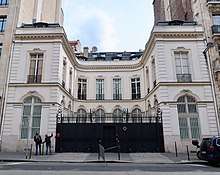Wildenstein Institute
The Wildenstein Institute is a French art institute that publishes catalogues raisonnés and scholarly inventories.

History
The Institute was founded in 1970 by Daniel Wildenstein as the Fondation Wildenstein, and it was renamed the Wildenstein Institute in 1990. It is an offshoot of the art dealing company (Wildenstein & Co.) owned by the Wildenstein family for five generations.
It houses the historic documents and photographic archives assembled by Nathan Wildenstein (the company founder) and his son Georges, which have been added to by subsequent generations.[1] Daniel Wildenstein established the Wildenstein Index Number used by the Institute to identify paintings.
It publishes catalogues raisonnés and scholarly inventories of impressionists such as Monet, and other modern artists such as Gauguin.[2] It describes itself as a center for research in art history.[3] It is currently headed by Guy Wildenstein.
Controversy
The Institute publishes a Monet catalogue raisonné and is regarded as the "official" authenticator of Monet paintings.[4] Acceptance of a Monet by the Institute significantly increases the commercial value of a painting. The Institute controversially refused to authenticate Bords de la Seine à Argenteuil after an investigation by Fiona Bruce (a journalist) and Philip Mould (an art dealer and historian) in the BBC television programme Fake or Fortune?, which first aired on 19 June 2011.[5][6] The Institute has featured again on the programme, variously accepting and rejecting the team's efforts.
Another controversial finding featured on Fake or Fortune?, first aired July 2015, involved a painting purported to be by Pierre-Auguste Renoir held at Picton Castle, Wales. The Bernheim-Jeune is one of several sources that established provenance for the "Picton Renoir." The BBC investigators unearthed several lines of authenticity, including additional levels of provenance with photographic records of sale and forensically matching pigments and canvas to Renoir. The Bernheim-Jeune geune Gallery had approved the painting as genuine and have included it in Renoir's catalogue raisonné. The Wildenstein Institute declined to accept the painting citing insufficient evidence. [7][8][9]
In 2011, a police raid discovered and seized 30 paintings valued at tens of millions of pounds from the Institute's Paris headquarters (see: Guy Wildenstein#Criticism).[10]
Notes
- "The Wildenstein Institute". Christies. Retrieved 12 July 2018.
- Maloney, Jennifer (29 January 2014). "Qatar Buying Art Dealer Wildenstein's Manhattan Headquarters". The Wall Street Journal. Retrieved 12 July 2018.
- Institute web site
- Flynn, Tom (8 July 2011). "More on the Monet rejected by the Wildenstein Institute". Retrieved 12 July 2018.
- "Monet". Fake or Fortune?. Episode 1. 19 June 2011. BBC. Retrieved 4 August 2011.
- Freeman, Len (2011-06-19). "BBC programme preview". BBC News. Retrieved 2012-04-28.
- Art, Read Article Fridaadministrator Posted: 1 year ago Read Time: 5 minutes Best of The RestFashionGalleriesThe Week That WasWhat's on EuropeWhat's On LondonWhat's On OutdoorsWhat's On UKWorld (2017-09-20). "Art in The Week That Was". Art Today Magazine. Retrieved 2019-01-17.
- "The 'Picton Renoir' - On View in Picton Castle". Picton Castle & Gardens. 2018-04-09. Retrieved 2019-01-17.
- Editor, Richard Brooks, Arts (2015-07-12). "Case of mystery ‘Renoir’ solved". The Sunday Times. ISSN 0956-1382. Retrieved 2019-01-17.CS1 maint: extra text: authors list (link)
- Samuel, Henry (2 February 2011). "Artworks worth millions seized from Wildenstein Institute". The Telegraph. Retrieved 12 July 2018.